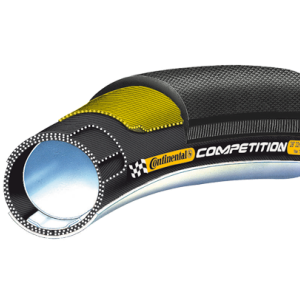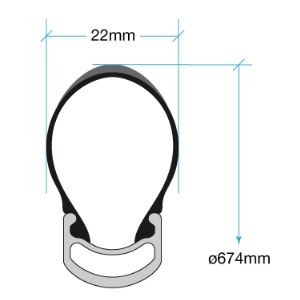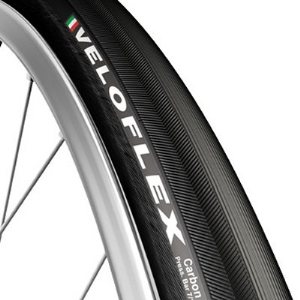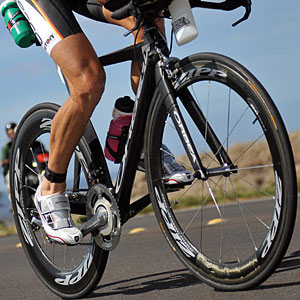Fast Tires for 2012 – 1

What we offer in this two-part article is an overview of current tire offerings, clincher and tubular, for all major brands. Consider this an "as-of-early-2012" summary of what’s out there. We focus primarily on tires sold as race-intended, but will also mention manufacturers' other notable offerings. Part 1 will cover what we can consider the larger or widely-known and available options; Part 2 covers the smaller, unique, or otherwise lesser known options.
Our goal is not necessarily to offer a spec sheet with to-the-gram weight specs, exact measured width, aerodynamic drag, or specific Coefficient of Rolling Resistance (Crr). Rather, it is to offer an aggregate of these, along with subjective first-person evaluation. In effect, to distill the data to What really matters for Joe Triathlete of any skill level.
For the sake of simplicity, we assume that any Crr data mentioned is according to Al Morrison’s work on BikeTechReview. Over time, this has grown to a sizeable resource, and the stalwarts of the Slowtwitch forum tend to support it as valid. Crr is like a golf score: lower is better. The balance that comes in to play, however, is a tendency towards "faster" tires also being more prone to punctures. Let me repeat that: a tendency towards "faster" tires also being more prone to punctures. It is not a universal catch-all.
The reasoning behind this is simply a matter of physics. The fastest rolling tire, on paper, looks something like this: Thin, immaculate quality high-thread casing with an equally paper-thin and buttery-supple tread. No puncture-resistant breaker, and a latex inner tube. You see, the more flexible, soft, and springy a tire is, the faster it will roll down the road. This is why a lower air pressure than the old Conventional Wisdom proves faster (although we’d now call it "appropriate" pressure).
A supple, flexible tire coupled with a reasonable pressure makes a system that is more willing to conform to less-than-perfect road surfaces. Even with a seemingly glass-smooth surface, there are microscopic imperfections that you can't notice through the dampening of your tires, wheels, frame, saddle, and bib shorts. But they’re there. Think of it as a very small scale version of what a mountain bike sees. Their log crossing may be akin to a dimple in the road. Both have an effect on your forward travel, just scaled appropriately. What you want is efficient storage and return of energy while traversing these obstacles. A tire and tube system that "rides nice" isn’t simply smoke and mirrors. Your thick butyl tube and training tire don’t absorb and return as much energy as a thin racing tire and latex tube, which are more elastic. On a non-suspended bicycle—whether for road or mountain —your tire IS your suspension. To go faster, we want to put less energy in to the up-and-down motion of the bicycle, and more towards forward travel.
The devil’s advocate will mention, however, that a low Crr is worthless when you puncture halfway through the race, so we will also note the relative durability of each tire offering. Again, there will be those who inevitably have had a bad experience on any tire in the marketplace, so this must be taken with a grain of salt. Weight is nary on our radar for tires, so this will be mentioned only if it is an outstanding case.
The new story in tires these days is aerodynamics. With so much information out there—different wheels, tire widths, and testing protocols—there is a lot of noise in the data. Some of the tires that aren’t even specifically sold as aerodynamic have shown to be quite so in independent tests. And some of the tires that are sold as aerodynamically-superior have been trounced by their not-specifically-aero cousins. With these considerations, we will largely avoid this topic and rely on continued testing by the experts for you to form an opinion on what tire is the most aerodynamic.
Vittoria
Vittoria has long been known as a leader in 'skinny' tires; those intended for road racing, triathlon, and time trial. Their flagship model, known as the Corsa CX tubular, has seen many iterations, and remains an industry leader. It is also available in a clincher version known as the Open Corsa CX. Vittoria uses the term "open tubular" to tell us that this isn't any ordinary clincher tire—it has an identical casing anatomy to its tubular brethren (That's its marketing department saying, "See?! High quality!").
However, instead of being sewn together with an inner tube stuck inside, the casing is left open and features clincher beads. Theoretically it has the same ride quality as the tubular version. In my experience, they largely live up to the hype. It is worth mentioning that the primary reason for the folklore of "tubular tires ride better" is due to the fact that most of the high-end tubular product features a natural latex rubber inner tube (and it’s superior elasticity); and that relatively few latex options are available for clinchers. We all grew up with good ol’ synthetic butyl rubber tubes for training.
Vittoria has sold various different iterations of the Corsa CX over the years. Most notably the Crono version sold in a single width and thin, lightweight casing. The Crr data shows it at the top performing Vittoria offering currently sold. However, I would not put it ahead of the original Corsa CX in terms of overall triathlon usage (which has more width options, better puncture resistance, and still is on the low end of the Crr spectrum).
On the topic of puncture resistance, that is the only consistent knock against the Corsa product. This author has a personal patchy history with the tire, along with the Zipp Tangente which shares the same casing but a unique tread mold. In a decade of racing, I’ve racked up a total of three flats during races on these tires, and zero from any other brand (including Continental, Michelin, and Schwalbe). All were eerily similar: Mystery puncture through the tread. Nothing stuck in the tire, no visible glass on the road, different inner tube materials. It went from JRA (Just Ridin’ Along) to flat tire. However, Slowtwitch’s own Slowman himself loves the tire, and has had none of the same experience. Go figure. More conservative types will be better off with the Rubino Pro; traditionally only available in clincher, but more recently in a tubular model as well. This tire is marketed as a step between their Zaffiro training tire and the racing-only Corsa, but will do you just fine as a safe, durable, do-it-all tire. Beginning triathletes could do much worse.

Continental
Continental is another industry icon with rich history. Traditionally labeled as the not-as-fast but rock-solid-durable evil twin to Vittoria, it has seen many a race win on the ProTour circuit and in the lava fields of Hawaii. The stars of the tubular line-up are the Competition and Sprinter. The Competition is slightly heavier, more durable, and available in more widths. The Sprinter is slightly lighter, less durable, and available in one width (akin to the Vittoria Corsa Crono). Tech geeks will suggest that neither of these tires are your best triathlon-racing choices due to the fact that Continental uses butyl inner tubes in all of their retail-sold tubular tires. The upside is that they don’t leak air down overnight (latex is more porous than butyl), but the clear downside is a measurable increase in Crr (Note that it’s no secret that Continental-sponsored ProTour teams and top-level triathletes like Craig Alexander receive custom-made tires featuring latex inner tubes—but you can’t have them).
Both tires will certainly have favorable puncture resistance compared to all of the lightweight/thin “racing-only” options in the marketplace. For this reason, I predict that they will remain sales leaders; some people just don’t want to deal with flat tires. Continental also now offers a Grand Prix 4000 tubular in a single width, but we don’t know what void this tire is attempting to fill. Conti’s own website states that this tire is “The challenger” and “has high ambitions”. Well, I like steak and red wine for dinner… so what? If nothing else, we know from the Crr data that the GP4000 tubular is slower than the Competition and Sprinter, so we’ll pass on it for now.
The clincher line-up is where Continental has gone from a middle-of-the-pack performer to super star as of late. The Gatorskin and GP 4-Season have always been great training tires, available in up-to-28mm width. The GP4000 clincher was never a fast roller, but got the job done. There is the Grand Prix Supersonic; a very fast rolling tire, but suffers the reputation as a very fragile tire. A few years ago, however, Conti introduced a tire that blew the socks off of everyone: the GP4000 “S”. With a newly-engineered compound, it had much improved rolling resistance over the standard ‘4000, cornering grip to spare, and good puncture resistance. In a very comprehensive test done by the German Tour magazine, the 4000 S trounced all other competitors, setting a new standard in clincher tire performance. As it turns out, various independent wind tunnel tests also showed the tire happened to be fantastically aerodynamic.
Then—in the race heard ‘round the triathlon world—it happened. In the historic fashion, it took a ProTour road cyclist to validate our insecurity in equipment choices, as Tony Martin won the World Time Trial Championship aboard clinchers. Rest easy, because you can now race clinchers without shame or hiding it from your non-tri friends. Tony rode a prototype Continental Grand Prix TT tire wrapped around Hed clincher wheels, at 7 bar (102psi). Seems like he knew something nobody else did. Conti product has always impressed me with seemingly very consistent quality, casing shape, and durability to spare—and I suspect they will continue to find success.
Michelin
Michelin has been an interesting brand to follow. To put it simply, they don’t have a lot of options, but haven’t necessarily needed them. The Pro tire has seen a series of updates, with the simple addition of a number to the title as it evolves (the Pro 4 now being sold). There has always been a “Light” version sans puncture strip, and improved rolling resistance to match. Both tires have generally good Crr, grip, and puncture resistance. We’ll call the Light version for short-course folks and the standard Pro4 for long course or those who are risk-averse. They’ve got good product, plain and simple.
The glaring void, however, is in tubular product. Michelin doesn’t make it. Their sponsored ProTour teams seem to ride a mix of clincher wheels with real Michelin tires, and carbon tubular wheels with re-branded tubulars from other manufacturers. I don’t know why they refuse to get in this market, but I don’t see it changing any time soon. Tubular customers look elsewhere.

Bontrager
Bontrager is a brand that has effectively burst on to the triathlon scene in a big and legitimate way, by way of a single product, and in very recent history. This, of course, is the 22mm R4 Aero tire (a schematic of its cross section is adjacent). According to Bontrager, the shape of the casing and “wings” help to blend the tire/rim interface, make the tire phenomenally aerodynamic. How much, we don’t really know. We do know that the Crr is quite good, making this tire—on paper—a very fast clincher choice for racing. Bontrager themselves do not recommend the tire for training, which tells me that the puncture resistance lies somewhere in the bottom half of the bell curve. Fine with me, ‘long as we know what to expect (and I always appreciate full-disclosure).
Aside from the excellent R4 Aero, the rest of the lineup has highs and lows. Names change, usually between some combination of “Race”, “Lite”, “X”, “Hard Case”, and the new “R” moniker. My experience is that they generally have good racing-intended tires, but the training-intended tires leave something to be desired. Sidewalls and tread come apart, and the puncture history seems to be higher-than-normal. The reputation in mountain bike tires seems quite good; time will tell if the entire road line-up can make the grade.
[Publisher's note: I hope you like this fantastic debut article from Greg Kopecky, our new editor-of-things-that-roll. He comes to us from SRAM/Zipp, so he knows his stuff. Look for Part-2 on Wednesday.
One note on Bontrager: The R4 Aero does include a puncture protective belt, and according to Bontrager its race recommendation has to do with longevity and wear, not flats. I have many training miles on the R4 (notwithstanding Bontrager's guidance) and while it does not have the wear life of, say, a Conti GP4000, I can't – N=1 – remember ever flatting. Of course, now I've just jinxed my next training ride. -Slowman]




Start the discussion at slowtwitch.northend.network